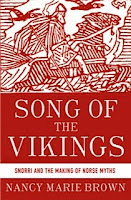Song of the Vikings: Snorri and the Making of Norse
Myths has reached that delightful stage called
“advance reader copies,” or ARCs—delightful for the writer because I get to see
the final cover design, read my publisher’s description of the book, and (best
of all) relish the first readers’ comments, or blurbs.
How Palgrave Macmillan describes Song of the Vikings:
“Snorri Sturluson, the thirteenth-century
Icelandic chieftain who gave us Odin, Loki, and Thor, was as unruly as the
Norse gods he created.
“Much like Greek and Roman mythology, Norse myths are still with us.
Famous storytellers from JRR Tolkien to Neil Gaiman have drawn their
inspiration from tales of the long-haired, mead-drinking, marauding and
pillaging Vikings. Their creator is a thirteenth-century Icelandic chieftain by
the name of Snorri Sturluson. Like Homer, Snorri was a bard, collecting and
embellishing the folklore and pagan legends of medieval Scandinavia. Unlike
Homer, Snorri was a man of the world—a wily political power player. One of the
richest men in Iceland, he came close to ruling it and even closer to betraying
it… In Song of the Vikings, author Nancy Marie Brown brings Snorri
Sturluson’s story to life.”
Jeff Sypeck, author of Becoming
Charlemagne, wrote:
“For readers who’ve long sensed that older winds blow through the works
of their beloved Tolkien, Song of the Vikings is a fitting refresher on Norse mythology. Without stripping
these dark tales of their magic, Nancy Marie Brown shows how mere humans shape
myths that resonate for centuries—and how one brilliant scoundrel became, for
all time, the Homer of the North.”
Scott Weidensaul, author of The First Frontier, said:
“In medieval Iceland, one of the most remote
corners of the known Earth, a very un-Viking Norseman named Snorri Sturluson
crafted the heroic mythology on which rests everything from Wagner’s Ring cycle
and the Brothers Grimm to Tolkien (who considered Snorri’s work more central to
English literature than Shakespeare’s) and even the evils of Nazism. In Song of the Vikings, Nancy Marie Brown
brings to vivid life this age of poetic Viking skalds, of blood feuds and
vengeance raids, of royal intrigue and fierce independence, when the barren,
beautiful landscape of the North was haunted by trolls, giants, and dragons—all
of which Snorri, the most important writer the world ever forgot, captured for
eternity.”
Why are
ARCs delightful?
Because they got it. “Unruly”
is the perfect word to describe Snorri Sturluson and his creations—and I didn’t
think of it. “How mere humans shape myths” is an excellent summary of my
theme—again, I wish I’d written it. A medieval Icelander influenced Wagner,
Grimms’ Fairy Tales, Tolkien, the
Nazis—yes, that’s the point I was making, that and the importance of not
forgetting a great and influential (if unruly) writer.
Song of
the Vikings won’t be in bookstores until October, but I’ll be
sharing more about it in posts throughout the summer and early fall. Meanwhile,
I’m planning my book tour. If you’d like me to visit your library, local
bookstore, bookclub, or school, please let me know.
And if you’re lucky enough to attend Book Expo America in New York next
week, stop by the Palgrave Macmillan booth and pick up an ARC of Song of the Vikings.












